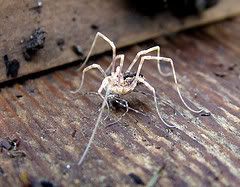Spiders
dragon flies mating
scorpion with babies
Reproduction in an arthropod requires a male and a female of the same species to mate in order to form offspring. The males produce sperm while the females make eggs, they are then fertillized. Some arthropods lay their eggs while others carry them. An example of an arthropod that carries the eggs would be a scorpion, when the babies hatch they crawl out on to her back until they are ready to go on their own.
Arthropods eggs must stay moist so most lay them on or near the water; however, some keep their eggs moist in other ways. For example spiders create an egg sac that wraps around the eggs like a cocoon, which also protects them from predators.
There are also few arthropods that guard their eggs in special openings of their exoskeleton for example the crab or shrimp.
Arthropods that live in colonies will work together to watch over the eggs of all members, for example bees and ants.

Growth
In order for an arthropod to grow they must molt or shed their exoskeletons, during this process the arthropod is completely defenceless from predetors, therefore they hide. The process of molting can take from a few hours to a few days.
Development


Incomplete Metamorphosis
-hatch from eggs
-look like adult form
-when young, they lack adult structures such as sex organs and wings
-keep molting until they reach adult stage during that period they acquire adult characteristics
Complete Metamorphosis
-eggs hatch to larvae(look nothing like the adult)
-larvae molts to get bigger but hardly changing in appearance
-then larvae sheds larval skin becoming a pupa
-pupa stage -insect body breaks down larval structures in order to supply raw
materials for adult structures
-when complete the "adult" emerges
-adult is compeltely different from befor(internal and external)
-Metamorphosis controlled by complicated interaction of hormones(including molting hormone)
-juvenile hormone helps keep it in the right stages depending of maturity
-the hormones are critical to the arthropods development
No comments:
Post a Comment